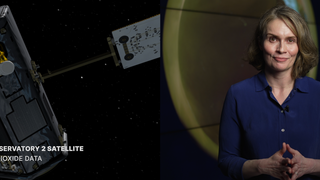USFS/GEDI Old Growth Forest Visualizations
This visualization begins with a view of USFS Forest Inventory and Analysis (FIA) plot locations (orange dots) across the continental US. GEDI vegetation height data then draws on dynamically, showing how data from both the USFS and NASA can be used together to increase spatial coverage.
The U.S. Forest Service has studied mature and old-growth forests – broadly characterized as forests at an advanced stage of development – in hundreds of thousands of plots across the country. To define, identify, and create the first formal accounting of these national resources, the team assessed decades of field-gathered Forest Inventory and Analysis (FIA) data covering a wide variety of forest types and ecological zones across the country.
Complementing the Forest Service’s analysis, NASA-funded scientists are drawing on a space-based instrument called GEDI (Global Ecosystem Dynamics Investigation) to provide a broad and detailed picture of these forests. From its perch on the International Space Station, GEDI’s laser imager (lidar) is able to peer through dense canopies to observe nearly all of Earth’s temperate and tropical forests. By recording the way the laser pulses are reflected by the ground and by plant material (stems, branches, and leaves) at different heights, GEDI makes detailed measurements of the three-dimensional structure of the planet’s surface. It can even estimate the weight and stature of individual trees.
The Forest Service plans to work alongside NASA to gather aerial and satellite imagery and map mature and old-growth forests at finer scales. Such data can also help the Forest Service create a long-term monitoring system. Meanwhile, a team of interagency experts will analyze and assess threats and risks to these areas.
This visualization is a close up view of GEDI’s 8 beams, depicting vegetation height (rh100) with a white line and vertical profiles of Plant Area Index (pai_z) represented by scaled, color-coded spheres.
This visualization begins with a view of several orbits of GEDI data, then the camera zooms into a specific region scientists have identified as an example of an old growth forest. This particular example is in the Northwestern US.
This visualization begins with a view of several orbits of GEDI data, then the camera zooms into a specific region scientists have identified as an example of an old growth forest. This particular example is in the Eastern US.

A sample region of GEDI aboveground biomass data, compared to US firesheds.

A closer view of a sample region of GEDI aboveground biomass data, compared to US firesheds.

A view of GEDI aboveground biomass data mapped to US firesheds.

Legend - GEDI Vegetation Height Above Ground and Forest Inventory and Analysis marker

Legend - GEDI PAI altitude diagram

Legend - GEDI Plant Area Index (PAI)

Legend - GEDI Aboveground Biomass

Overlay map highlighting the location for the old growth example zoom in (East US)

Overlay map highlighting the location for the old growth example zoom in (Northwest US)
Credits
Please give credit for this item to:
NASA's Scientific Visualization Studio
-
Visualizer
- Kel Elkins (USRA)
-
Producers
- Katie Jepson (KBR Wyle Services, LLC)
- Jefferson Beck (KBR Wyle Services, LLC)
-
Scientists
- Benjamin Poulter (NASA/GSFC)
- Jamis Bruening (University of Maryland)
-
Science writers
- Sally Younger (NASA/JPL)
- Jenny Marder Fadoul (Telophase)
-
Technical support
- Laurence Schuler (ADNET Systems, Inc.)
- Ian Jones (ADNET Systems, Inc.)
Release date
This page was originally published on Thursday, April 20, 2023.
This page was last updated on Monday, March 10, 2025 at 12:13 AM EDT.
Datasets used
-
Relative Height [GEDI]
ID: 1131RH100 or relative height is the 100th percentile of waveform energy relative to ground elevation. Derived from the L2B LIDAR metric RH100 data product.
This dataset can be found at: https://gedi.umd.edu/
See all pages that use this dataset
Note: While we identify the data sets used on this page, we do not store any further details, nor the data sets themselves on our site.

![Full 8K resolution. Optimized for Earth Information Center display.Music credit: "Magical Moments by Liam Joseph Hennessy [ PRS ]" and “Strategy Meeting by Brice Davoli [ SACEM ]” from Universal Production MusicThis video can be freely shared and downloaded at https://svs.gsfc.nasa.gov/14606. While the video in its entirety can be shared without permission, the music and some individual imagery may have been obtained through permission and may not be excised or remixed in other products. Specific details on such imagery may be found here: https://svs.gsfc.nasa.gov/14606. For more information on NASA’s media guidelines, visit https://nasa.gov/multimedia/guidelines.](/vis/a010000/a014600/a014606/EIC_FIRE_FINALCUT_CENTER_ONLY_7680x2160_30fps_AAC_4800Hz_Stereo_071224_GAW.00110_print.jpg)